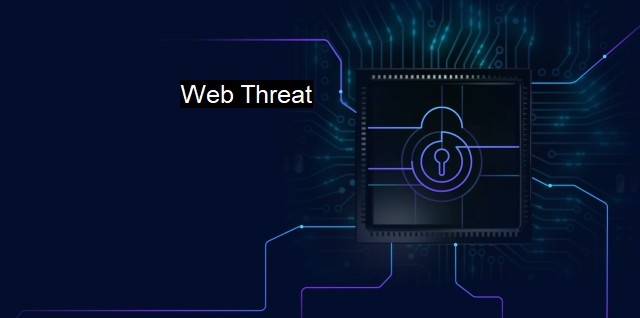What is Web Threat?
Understanding Web Threats: Identifying and Mitigating Risks to Online Security and Privacy
The concept of a "Web Threat" is a crucial component. A Web threat is any potential danger that can cause harm to a computer system, network, or web environment's safety and privacy. These threats manifest in various forms, such as viruses, malware, spyware, ransomware, phishing scams, and more, intended to infiltrate or violate a computer system. These malicious episodes aim to steal, alter, or wipe out sensitive data, interfere with computer operations, or use systems to initiate attacks on others.Web threats are a significant concern in our increasingly connected world, specifically in the domain of antiviruses and cybersecurity, where threats from the web can create havoc on systems and provoke far-reaching consequences. In a simplified perspective, if the internet is a global metropolis, web threats can be analogous to the various forms of crime found within the respective city.
Web threats greatly vary and evolve, which makes them more unpredictable and hence, perilous. There are numerous types of web threats that pose a risk to cybersecurity.
Viruses, one of the most common forms of web threats, are malicious software designed to replicate themselves and spread to different devices. Viruses often manipulate or inflict damage to the device’s operating system and operational capabilities. Not only do they affect individual systems, but given their ability to propagate, they could easily spread across networks and compromise all devices within the network.
The term 'malware' covers an array of sinister software programmed by cybercriminals. This can include Trojan horses, worms, adware, spyware, ransomware, and the already mentioned viruses. These types of malware irrefutably pose substantial harm to the confidentiality, integrity, and availability of data.
Another critical web threat is phishing. Cybercriminals exploit this technique and send fake emails appearing to be from legitimate firms with the intent to induce individuals to reveal their personal information, like passwords and credit card numbers.
In terms of antivirus and cybersecurity, dealing with the threat posed by malware involves a mix of protective measures. The first defensive layer is antivirus software programmed to monitor, detect, and eliminate malware threats. Antivirus software is still considered the cornerstone for any individual’s or business's cybersecurity posture, even with evolved forms of threats like zero-day exploits and ransomware.
Still, antivirus mechanisms alone cannot always guarantee complete protection. A popular saying in cybersecurity is that it is not about if an attack will transpire, rather when it will occur. Hence, developing a recovery strategy for a situation of a successful web threat should imperatively be part of the cybersecurity plan.
Understanding web threats helps identify the areas that require the most protection and pushes technology enthusiasts to create innovative solutions. Various security measures such as firewalls, using HTTPS protocol, VPNs, frequent software updates, and encouraging safe browsing behavior can minimize the risk posed by web threats.
User behavior, though often overlooked, plays a critical role in web security. Password hygiene, recognizing phishing emails, being careful about sharing sensitive information online, understanding the risks of public Wi-Fi environments, all significantly impact the susceptibility to web threats.
Web threats, due to their evolving nature, has made the world of cybersecurity synonymous with a combat zone. The enemy is unseen, the attacks can come from all sides, and the battleground keeps moving. While the tech cognoscenti work consistently to protect systems and data, the war on web threats is percentage-based, far from an absolute triumph. Recognizing its core essence as a non-negotiable aspect of our online lives, learning more about them, how they work, how to evade them, and when attacked, how to recover them, is vital to safeguarding our data and preserving our vital digital privacy.

Web Threat FAQs
What is a web threat?
A web threat is a malicious activity or attack that occurs on the internet or web. It can involve the use of viruses, malware, phishing, and other tactics to steal information, damage systems or networks, or compromise online security.What are some examples of web threats?
Some examples of web threats include phishing emails, ransomware attacks, drive-by downloads, malicious pop-ups, and fake software downloads.How can I protect myself from web threats?
To protect yourself from web threats, you should use antivirus software, keep your software and operating system up-to-date, use strong passwords, avoid clicking on suspicious links or downloading unknown files, and be cautious about sharing personal information online.Can web threats be completely eliminated?
While it may not be possible to completely eliminate web threats, taking proactive measures to protect your online security can significantly reduce the risk of becoming a victim. Regularly updating your antivirus software and being cautious about your online activity can go a long way in preventing web threats from affecting your systems or networks.| | A | | | B | | | C | | | D | | | E | | | F | | | G | | | H | | | I | | | J | | | K | | | L | | | M | |
| | N | | | O | | | P | | | Q | | | R | | | S | | | T | | | U | | | V | | | W | | | X | | | Y | | | Z | |
| | 1 | | | 2 | | | 3 | | | 4 | | | 7 | | | 8 | | |||||||